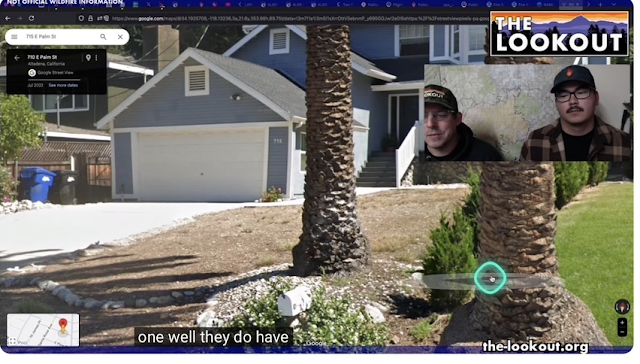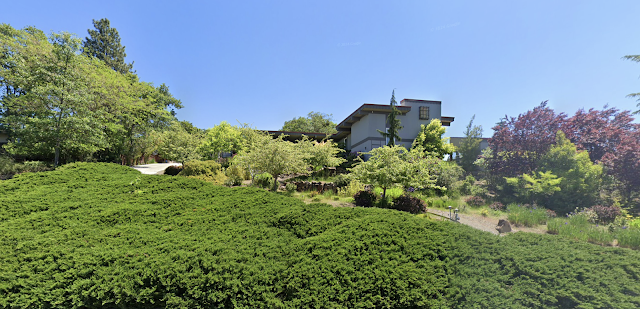They built the city that way because it is the way people like to live -- until it catches on fire.
Today's post is an invitation for readers to watch an hour-long video: Inside the SoCal Firestorms on YouTube.
You might want to watch it because you are interested in what all the fuss is about.
You might want to watch it because you want to know why your fire insurance might get cancelled, or tripled in price, even if you live in a city neighborhood of single-family houses with a fire station less than a mile away.
You might want to watch it because you should rethink your current landscaping.
I recognize that most readers won't give it that time, so I will give some quick photo highlights. If you do watch the video, don't be discouraged by the bad audio at the very beginning. They fix that promptly.
First, something unusual about the Palisades fire. It started at a high elevation and moved downhill, pushed by wind. It started in brush but then got into houses and moved from house to house downslope. Most fires move uphill. This fire got so hot that it moved from house to house across block after block of houses.
This Google street-view scene shows a Palisades neighborhood that looks like neighborhoods I see in Medford and all across America. It is a widespread idea of "the American Dream," single family homes on city lots with nice green vegetation.
Most homes have shade trees and privacy hedges, some more than others.
The narration called attention to this third blue-gray house. Notice their fire-resilience: bare ground, concrete, trees well away from their home.
It burned up anyway. The adjacent home burned, so it burned.
The narrators said that the lesson from the 2018 Camp Fire that destroyed 18,000 structures in Butte County, California, including the town of Paradise, was that the homes that survived were ones that were 60 feet or greater from another structure that burned.
Embers from burning houses spread to the next house.
A typical entry point is at the rafters, vents, and gutters. The narrators said that when firefighters see a house in this condition, they know the house typically cannot be saved.
Dry conditions and high Santa Ana winds made Los Angeles particularly vulnerable. The fire apparently started in brush land adjacent to city streets. But once the fire entered the developed area it burned houses along with the green, irrigated landscaping. Green vegetation became fuel, not protection.
People do not choose to live in bare ground and concrete. We like green plants. City planners and planning codes encourage density, not sprawl, so by intention urban and suburban houses are closer together than 60 feet. Denser cities make water, sewerages, and public transportation more efficient. But there are tradeoffs that become catastrophic under house-to-house fire conditions.
The conditions in LA were extreme, but not wholly different from conditions that exist in much of the western U.S. on a hot, dry summer day. Medford has three months of dry weather with frequent days of 100+ degree temperatures. Our winters are wetter than are LAs, but that means there is more vegetation to dry out in the summers. I am going to re-think my landscaping, especially the lovely, tall bamboo up against the wooden deck along the front of my house. Green juniper is a common ground cover in Medford. It is hardy, trouble-free, and deer don't eat it. But firefighters call it "gasoline brush" because it burns hot and intensely. That is dense juniper along the front of my house where a discarded cigarette could set it ablaze.
[Note: To receive this blog daily by email, go to: https://petersage.substack.com Subscribe. The blog is free and always will be.]










13 comments:
Thank you Peter.
Some of us live in areas of steep terrain where that vegetation keeps the hillsides stable. 35 years ago a mudslide on a 60 degree embankment behind the building we live in, moved the entire building off its foundation. It was fixed and remediated with retaining walls and plants to meet code. A plantless solution may not be feasible. Unsurprisingly we cannot get any earth-movement insurance….at any price. So we live with the risks.
Wood is one of the most affordable and sustainable building materials. Also the most flammable. Alternative materials are available but will drive up the cost of already unaffordable housing.
A complete rethinking of deeply embedded urban and suburban planning culture and regulatory systems in the midst of these dramatic climate realities will not happen quickly. Especially when the political camps are so acrimonious and “facts” are so subjective.
Yes. Everything is trade-off. The juniper in front of my house holds the hillside from eroding down. Good roots. To make a wakable, bicycle-frieindly city one needs density, but that is a fjire hazard. Sprawl allows people to have dry flammable yards in the hot Mediterrean climate. We want shade trees so we can use our decks. If we non-flammable siding we raise costs, so people will be homeless and camp and build fires in campsites on vacant park land and start infernos. Thank goodness we have simple answers to these questions by Jesse Watters.
Peter Sage's house is similar to the houses in Pacific Palisades, in that it's on a hillside, and there's tons of vegetation around his house and in his neighborhood. I know that Peter Sage has a swimming pool. I would suggest that you go purchase a gas-powered portable water pump for your pool, so that the pool provides a water-source to fight fires should a fire hit your neighborhood. The pump costs less than $500. https://www.harborfreight.com/2-in-212cc-gasoline-engine-semi-trash-water-pump-158-gpm-63405.html?utm_source=google&utm_medium=cpc&utm_campaign=21901739219&campaignid=21901739219&utm_content=173216763511&adsetid=173216763511&product=63405&store=811&gad_source=1&gclid=CjwKCAiAnKi8BhB0EiwA58DA4UXGZDBJEtuTHDWgFjuJgktuZ7VOCcdMUawGhG3jSxtP3zFp4X1dQhoCqxUQAvD_B
Peter, your problem is that you live in a wooden box with a landscape fuse. A survivable design would be a concrete box with a metal roof and hard exterior surfaces. Think 1950s Soviet design. Current building codes will not save you.
Good advice. I have two gasoline pumps I use at the farm, but one is extra and unnecessary. It is a Honda pump. Honda pumps have been very reliable for me and I am happy to recommend them. I have the necessary gear (foot valve and straw line plus the output.). There is also a backwash feature for cleaning the pool, and fifty feet of hose. I could get an extension of another couple hundred feet of flexible line to add to that. Good advice. (Note to beginners. You need about four other items to go with the pump: the part that goes into the pool and the part that come out of the pump that you connect a big hose onto that you will spray with. Do a dress rehearsal and start up the pump every week in the late summer months to be sure you and the pump are ready.) If I badly miscalculated protecting the place on my own, and the fire got away from me and surrounded me, possibly I could retreat into the pool and stay under water, just emerging for a second to breathe, although it is possible that the air would be too hot to breathe when the fire was nearby and at it hottest. The backwash requires the home to have electrcity working, but the gasoline pump would be a good soluiton to that. Again one wants a pump that starts on the first pull, really reliably.
Good: you’re thinking strategically!
You could also invest in a generator so that you could still have power if the electricity goes down.
In those neighborhoods that burned in LA, there is also going to be a huge problem of chemical contamination from all of the various plastic items that burned. Houses that did not burn may be uninhabitable due to this. And lots where the house burned may be too contaminated to build on.
I saw the piece on the news about the water pump system. I noticed it had a one gallon gas tank. That’s about 2 hours run time at best! Who is going to go into a wildfire zone the fuel up the pump?
The pump idea is good if it can be independently powered for at least 24 hours. Perhaps a 1 hp DC motor pump with a 20KWH battery. The batteries would have to be under ground and very close to the pump. A small sustenance charge could come from the electric grid. This would not be inexpensive !
What we are seeing is what happens when reality meets dreams.
Dreams are fueled by money.
Get ready for more corporate influence in government.
ODF tell me that my one by eight Douglasfir lap siding won’t catch fire unless there are embers piled up against it. The heat from a crown fire will only last seconds as the fire passes through, and won’t heat the wood enough to ignite it. My main weak spot is where wooden decks attach to the wood siding. To remedy that I have Sprinkler set up to keep the base of the siding wet when they’re turned on.
I also have Tesla Power Walls sufficient to keep my well pump running for days
Post a Comment